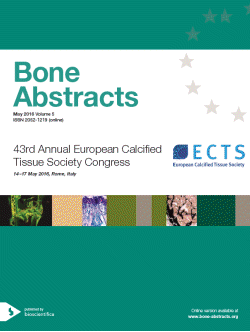
43rd Annual European Calcified Tissue Society Congress
Rome,
Italy
14 May 2016 - 17 May 2016

Oral Communications
Catabolism and metabolism
ba0005oc4.1 | Catabolism and metabolism | ECTS2016
A small molecule inhibitor of TRAF6 dependent signaling reduces osteoclastogenesis and prevents ovariectomy induced bone loss
Marino Silvia , Bishop Ryan , Bendle Gavin , Nicolaes Gerry , Lutgens Esther , Idris Aymen
ba0005oc4.2 | Catabolism and metabolism | ECTS2016
Inhibition of Sphingosine 1 Phosphate produced by Osteoclasts reduces chondrocyte catabolism and prevents osteoarthritis in mice
Cherifi Chahrazad , Hafsia Narjes , Latourte Augustin , Richette Pascal , Hay Eric , Cohen-Solal Martine
ba0005oc4.3 | Catabolism and metabolism | ECTS2016
Connecting the dots between bone and energy metabolism: the role of Lipocalin 2
Capulli Mattia , Gemini-Piperni Sara , Maurizi Antonio , Ponzetti Marco , Teti Anna , Rucci Nadia
ba0005oc4.4 | Catabolism and metabolism | ECTS2016
Osteocyte-specific ablation of Pparγ improves energy metabolism and prevents fat accumulation but not bone loss in response to a high fat diet
Brun Julia , Ferrari Serge , Bonnet Nicolas
ba0005oc4.5 | Catabolism and metabolism | ECTS2016
Effects of glucagon-like peptide-1 receptor agonists on bone blow flow and architecture in diabetic mice
Pereira Marie , Gohin Stephanie , Cleasby Mark , Chenu Chantal
ba0005oc4.6 | Catabolism and metabolism | ECTS2016
The myokine Irisin improves bone quality and strength
Colaianni Graziana , Cuscito Concetta , Mongelli Teresa , Pignataro Paolo , Liu Peng , Lu Ping , Mori Giorgio , Brunetti Giacomina , Yuen Tony , Sun Li , Reseland Janne , Colucci Silvia , Zaidi Mone , Cinti Saverio , Grano Maria



